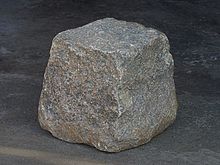Cobblestone
A paving stone is a building material for floor coverings mostly outdoors . A ceiling for traffic areas , which is called paving , is made from paving stones . Traditionally, paving stones are laid unbound, i.e. without mortar in the joints.
A paving stone for natural stone paving is a normally cuboid natural stone , which mostly consists of granite , granodiorite , gneiss , rhyolite , basalt , greywacke and suitable sandstones as well as marble and limestone . In the European Union there are standardized sizes according to EN 1342. Pebbles , reading stones or upright slab pieces also appear as paving as historical forms .
Brick or clinker paving stones used to be often laid when there were no natural occurrences nearby. They are more dimensionally stable, but their wear resistance is lower than that of conventional natural stones. Today, artificial stone pavement is often built from concrete blocks that can be manufactured as standard parts from several layers.
application areas
While paving stones used to be one of the common building materials in road construction, they are now mainly used in private areas such as for garage driveways, courtyard entrances, garden paths and terraces or for historical, mostly listed residential areas.
Trivia
Gingerbread or pepper nuts in hemispherical or cuboid shape are sometimes jokingly called paving stones. There are names for local variants such as Pulsnitz paving stones .
literature
- Reinhard Wendehorst: Baustoffkunde , Vincentz, Hannover 2004. ISBN 3-663-11830-4 .
